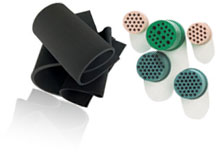Neoprene
Description: One of the earliest of the synthetic materials to be developed as an oilresistant substitute for Natural Rubber, Neoprene is a homopolymer of chloroprene (chlorobutadiene).
 |
Hardness (Shore A): 40 to 90.
Features: Neoprene can be used in innumerable sealing applications, due to its broad base of such desirable working properties as: moderate resistance to petroleum oils; good resistance to ozone, sunlight and oxygen aging; relatively low compression set; good resilience; and reasonable production cost.
Due to its excellent resistance to Freonll and Ammonia, Neoprene is also widely accepted as a preferred material for refrigeration seals.
Limitations: Neoprene is generally attacked by strong oxidizing acids; esters; ketones; chlorinated, aromatic and nitro hydrocarbons.
Because Nitrile is economically competitive with Neoprene, and generally has superior performance characteristics in most situations, it has largely replaced Neoprene in the Orings of today.




